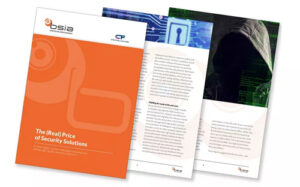 A white paper commissioned by the BSIA has established the importance of making purchase decisions based on quality – rather than initial purchase price alone. The paper, titled “The (Real) Price of Security Solutions – a white paper on the challenges of buying and selling high-quality security solutions”, has been authored by Dr Terence Tse, an Associate Professor of Finance at ESCP Europe Business School. It was sponsored by BSIA member companies Securitas and ATEC Fire and Security.
A white paper commissioned by the BSIA has established the importance of making purchase decisions based on quality – rather than initial purchase price alone. The paper, titled “The (Real) Price of Security Solutions – a white paper on the challenges of buying and selling high-quality security solutions”, has been authored by Dr Terence Tse, an Associate Professor of Finance at ESCP Europe Business School. It was sponsored by BSIA member companies Securitas and ATEC Fire and Security.
The paper aims to explore the price versus quality debate from the perspectives of both buyers and sellers of security solutions, in order to identify the relative advantages and disadvantages between low-priced and high-quality solutions. The main findings of the paper clearly suggest that end users would find it far more beneficial to consider and deploy high-quality security solutions. The findings also reveal that there are many advantages for security providers who offer high-quality solutions to their customers, rather than merely competing with each other on the basis of price. Security providers would be much better off collaborating with their customers and developing a good understanding of buyers’ needs in order to provide suitable solutions that meet those requirements and perform well over time.
The research was driven by Immediate Past Chairman of the Association, Pauline Norstrom, during her time as Chairman. In her final address to the Association as Chairman, Pauline announced that the Association would be conducting research into the issue of considering quality over and above price, which is of particular interest to her. “I have been in the industry some 16 years, before that in tech marketing across a broad spectrum of industries,” said Pauline. “During that time, I have watched and experienced the manufacturers within our industry race to the lowest price, compromising on materials and functionality in order to do so and often at the expense of UK jobs in the process. I have seen the industry rush to the cheapest price to win the bid, with companies offering solutions at very low margins being left with substantial additional costs they cannot cover. In addition, end users are often provided with an inferior solution which does not solve their problems.”
“I hope that the white paper will provide educational value to both industry players and security buyers,” explains Pauline. “For the industry, I hope that the white paper will enable us to communicate the valuable benefits of procuring solutions on the basis of quality. Especially when the cost of not paying for a service or extra warranty, or system design or customisation, is properly measured across the life of the system, and considered in terms of the whole cost, including the displaced cost to a business and its current operations.
“I also hope that it will help end users to think in terms of the wider business impact of security purchase decisions, to challenge the brief and to consider the displaced cost which may arise. Essentially, I hope that the paper will educate the security buyer as to the art of buying a specialised security solution, rather than a bunch of part numbers or just cost per hour; and instead, to consider the value of the sum of the parts bringing a larger benefit than those parts working in isolation. It is the concept of the whole system, whether a service or product offering that the security industry needs to explain to the security buyer, and I hope that this white paper achieves that,” concludes Pauline.
The paper sets out recommendations for both security providers and security buyers through checklists which aim to help security buyers make better informed purchase decisions and security providers to better demonstrate the value of their offering rather than compete on price alone.
Pauline Norstrom and representatives from both Securitas and ATEC Fire and Security will be presenting on the findings of the white paper in more detail at the BSIA’s North West Security Procurement Conference which is being held in Liverpool on the 3rd May.
The full white paper can be downloaded here

